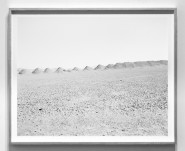JTF (just the facts): A total of 17 black and white photographs, framed in silver and unmatted, and hung against white walls in the main gallery space and the entry area. All of the works are gelatin silver prints, made between 2012 and 2019. The prints are sized roughly 11×13 or 20×24 inches, and are available in editions of 5. (Installation shots below.)
A monograph of this body of work was published in 2018 by MACK Books (here).
Comments/Context: The desert regions of the American West are notoriously harsh and unforgiving. Scalded and cracked by the unrelenting sun, dusty expanses of rock and sand stretch to the horizon, the stark, largely uninhabited landscape interrupted only by low rise hills and stubborn scrubby plant life. The indifference of these places is often seen as alien or otherworldly, and an unlikely romance is rooted in their hardness, where human limits of endurance, perseverance, frontier spirit, and even survival are severely tested.
Documenting these landscapes photographically first fell to the 19th century survey photographers like Timothy O’Sullivan, who offered us grandly beautiful vistas of land and sky, intermittently populated by dangerously vulnerable explorers and wagon trains. And as the American nation expanded and began to brush up against (and colonize) the desert more regularly, photographers like Frederick Sommer, Lewis Baltz, Robert Adams, and others showed us desiccated dead animals, disorienting fields of rock and cacti, and the sometimes grim intrusions of encroaching human settlement.
Susan Lipper’s Domesticated Land project knowingly follows in the footsteps of these historical image makers. And while her images thoughtfully wrestle with the aesthetics of the desert as defined by these artists, they also introduce an alternate vantage point that recalibrates the our sense of what her pictures actually document.
Domesticated Land is the third part of a trilogy of projects that Lipper has been working on for the better part of the past three decades (preceded by Grapevine (reviewed here, in 2016) and trip (reviewed here, in 2018).) All three series are tied together by the idea of an unnamed witness wandering the back roads of America in search of its truths, a backstory that recalls that of countless masters of the medium. This conceptual framework provides Lipper with several important freedoms – she is, and is not, the protagonist in her solitary, multi-stage road trip through different parts of the country, and this deliberate artistic distance allows her to introduce elements of fiction into a typical documentary structure. Her pictures also simultaneously engage with both the nuances of contemporary life and the male-dominated canon of photography, her presence becoming a reintroduction of a feminist perspective and an active dialogue with visual history.
Lipper’s black and white photographs wash the hazy skies and dirty wastes of the desert into an expanse of squint-inducing white. In many cases, the views are broad and empty, like the aftermath of some dsytopian environmental disaster, the textures scraped of color. Isolated, left behind objects catch Lipper’s eye like accidental still lifes, a pile of rusting tin cans, a squiggling snake, a wavy-paged guidebook, and a one-eared papier-mache pig’s head on a pole becoming symbolic messages (or perhaps warnings) left for those that might come after.
Other images document the stubborn traces of man-made alterations. The hard edged rectangles and squares of drive-in movie screens (now abandoned), solar panels, and other inexplicable installations of concrete and wire (an array of RV hookups?) seem to fight a losing battle with the ever-eroding land. Puzzling rounded mounds of dirt march across the horizon like haystacks or tombs, worn by time into soft rhythms. And forces of control linger on the periphery, from a tangle of black barbed wire to a pair of parked military vehicles, the masculine struggle for domination extending out to even these desolate zones. All of these photographs offer aesthetic echoes to those we have seen before, but also seem to change the narrative, making a lingering undercurrent of ominousness now more obvious.
The presence of women (both direct and indirect) works to counterbalance this dark mood. While deluded tiny figures seem to follow a winding path out into nothingness, we soon feel the calming presence of individuals, from a woman walking her small dog near the solar panels to another leaning over near the dark circular mouth of a cave (the most obvious manifestation of Lipper’s gendering of the landscape). Later, a group of people (probably friends out for a hike) emerges from a desert path like a band of awkward survivors. Presence even takes the form of a fragment of car mirror on the edge of a frame, that small intrusion transforming our sense of isolation and emptiness into something more collaborative.
Lipper’s pictures show us straightforward realities, but it’s hard not to apply alternate narratives to what we find there, seeing stories spin up in the swirling dust. The oscillation between clear documentary aridity and more personal engagement with the possibilities of the land creates a rich duality in these photographs – they occupy alternate conceptual planes at the same time, the real and the imagined constantly tussling. In Domesticated Land, Lipper cleverly pays homage to photographic traditions while incisively and thoughtfully dismantling them. It’s a tightly crafted and highly intelligent body of work whose dusting of understated light grey tones disguises a wealth of sophisticated thinking.

